Testing 3 Different Glues on my Lego Sets (Which is best?)
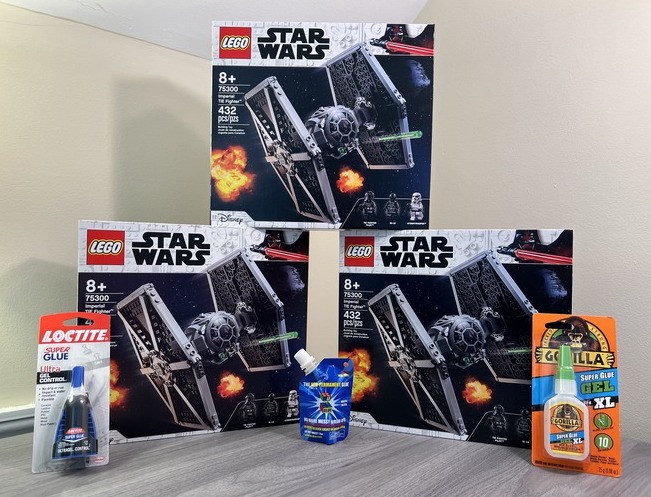
Recently, I was faced with the question, “What’s the best super glue for Legos?” I didn’t have a great answer because I’ve never super glued a Lego Set before. So, I bought three Lego Sets and three different super glues. I glued each one with a different super glue and smashed it to see how well each glue held up.
Items used in this article:
- LEGO Star Wars Imperial TIE Fighter 75300 (View on Amazon.com, Affiliate Link)
- Le Glue (View on Amazon.com, Affiliate Link)
- Loctite Super Glue (View on Amazon.com, Affiliate Link)
- Gorilla Glue (View on Amazon.com, Affiliate Link)
I receive a small percentage of your purchase when you use my affiliate links, at no extra cost to you. I bought three different glues and three Lego Sets for this article, which added up! If you decide to buy one of these glues, using my affiliate link supports my website. Thank you!
Which Glue is Best?
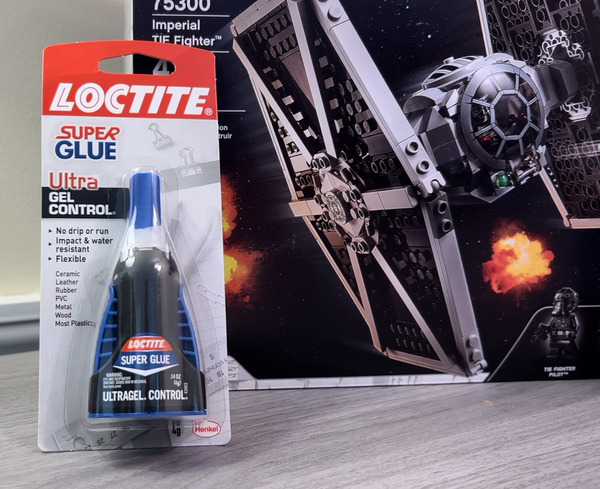
Loctite Super Glue
Loctite Super Glue was the easiest to build with. Its precission nozzle made it easy to dispense the right amount of glue, without any blobs or mess. It didn’t dry instantly, which made building so much easier. It’s permanent, and stronger than Le Glue. It’s not as strong as Gorilla Glue, which was too strong and difficult to use.
I purchased Loctite Super Glue on Amazon.com (Affiliate Link).
I’ll go through my experience building with Loctite Super glue, then Le Glue and Gorilla Glue. I want to walk you through the process as if you’re building with me. I’ll share my frustrations and wins, so you don’t have to go through the same learning curve when you superglue your Legos.
Loctite
Loctite glue will make for an easier build than other super glues because of its precision nozzle, and it’s stronger than Le Glue.
If I could recommend any glue for your next Lego project, I’d recommend Loctite. Just be comfortable with the fact that you’ll never be able to remove the glue from your Lego Sets. This was stronger than Le Glue, but not as strong as Gorilla Glue. It dries slower than Gorilla Glue as well, which makes building it easier. You can make a mistake and still have time to correct your error, whereas Gorilla Glue dries instantly!
I love the dispenser for this glue. If Le Glue or Gorilla Glue had the same dispenser, I wouldn’t be as harsh on them. It’s so precise and doesn’t make a mess. The only issue is that it’s small. It didn’t hold enough glue for the whole Lego Set, so I had to buy another. You’ll need one bottle for every 300 pieces, give or take. Larger pieces and plates take more glue than smaller bricks.
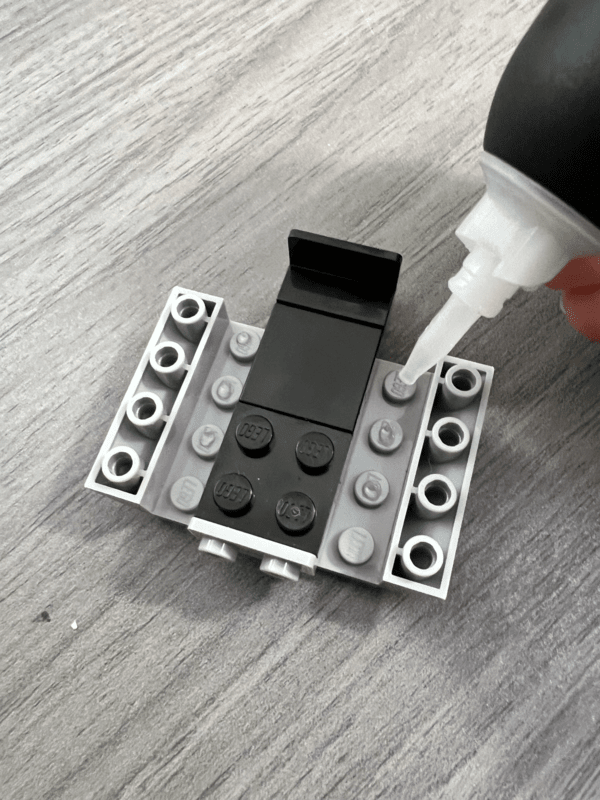
The only drawback that I can think of for this option is that the container doesn’t hold a ton of glue. Make sure you buy enough for your project at one bottle for every 300 pieces. It gets difficult to squeeze out enough when it starts to run low, which was a tire on my fingers. But, the good outweighs the bad for this glue. It’s my recommendation to anyone looking for the best glue for their Lego Sets.
Le Glue
Out of the three glues, Le Glue was the easiest to apply but the worst at keeping a Lego Set together, which you’ll see in the drop test later in the article. I rank it #2, closely behind Loctite glue. If it was a bit stronger, I’d rank it as number 1.
I can live with a weaker bind, but Le Glue is extremely messy to apply because of its large nozzle. You’re forced to leave huge clumps of glue on your Legos as you build, which makes a mess. You can see in the image below that the discharge of glue can be larger than the Legos you’re building with.
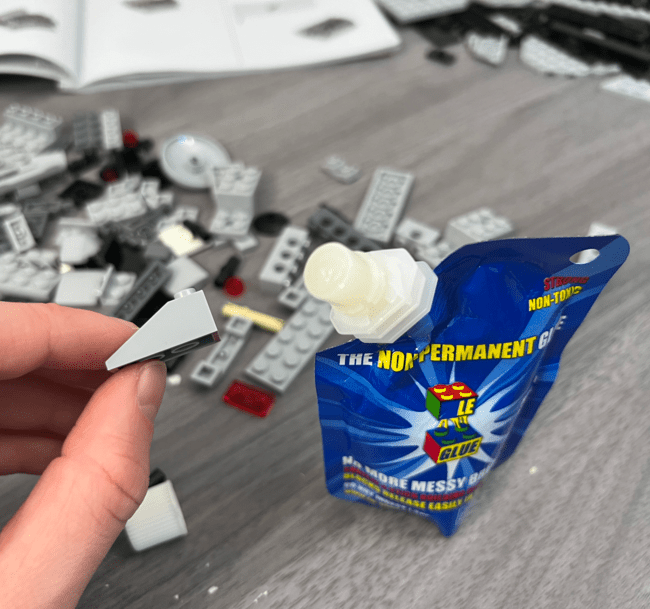
A unique feature of this glue is that it washes away. I tested this by washing the Legos I built with, which you can see in the images below. There was a clear residue of Le Glue that I was able to wash away with rubbing my thumb on the Lego in warm water.
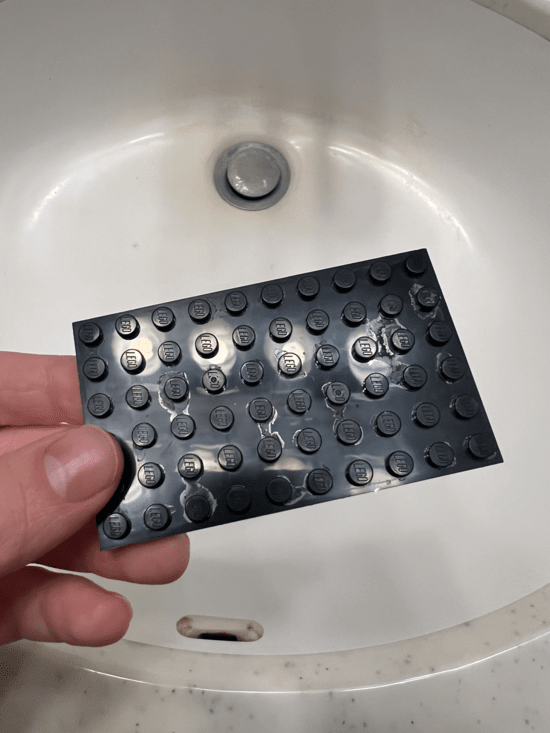
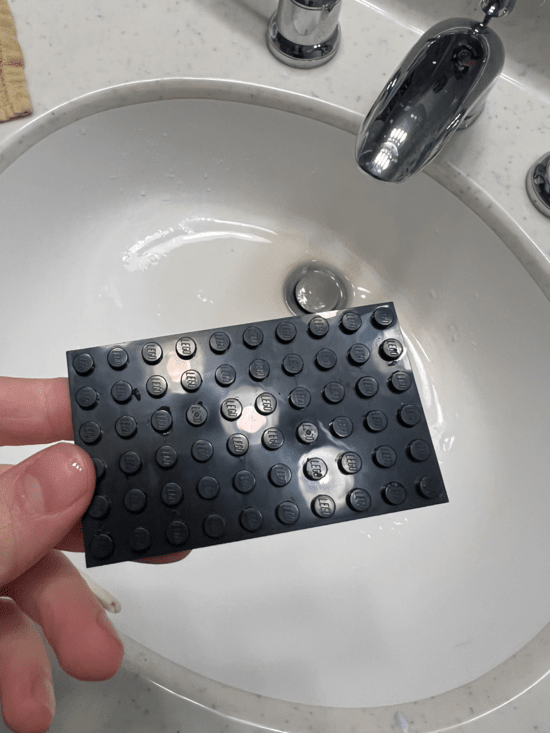
This is a huge benefit to Le Glue, which may set it above Loctite for some Lego Collectors. The biggest setback with superglueing your Legos is that they lose their resale value.
With Le Glue, you can wash away the glue and sell the Lego set as if it was never superglued. It will lose value because your opened and built the set, (If you’re curious, see my study to see how much it dropped in value) but it won’t lose as much as if you were to superglue the set.
The reason why I still put Loctite over Le Glue is because the strength Le Glue brings does not justify the time spent superglueing the Legos. Later in the article, I do the math to find that superglueing Lego Sets takes 68% more time than building it regularly.
I imagine someone who is willing to put in extra hours of work to superglue their sets does not want to only have a slightly sturdier set. They don’t want their set to break at all! Le Glue does not achieve that. Loctite is much stronger and easy to build with.
Gorilla Glue
Gorilla Glue is too serious for Lego builds. The glue is ultra strong, messy, and dries almost instantly. This left gaps in my build, made it impossible to fix mistakes while building, and got glue everywhere.
The glue came out in more controlled globs than Le Glue, more similar to Loctite globs. The difficult part is that the glue would dry nearly instantly, leaving gaps in between Legos as I built the Set. If I made a mistake, I would nearly snap the Lego as I tried to remove it. This made glue get everywhere. I had super glue on my fingers for a week after building this TIE Fighter.
At the end of the day, this was too strong for a Lego build. I would stick with weaker glue, such as Le Glue or Loctite, to make the building process more manageable.
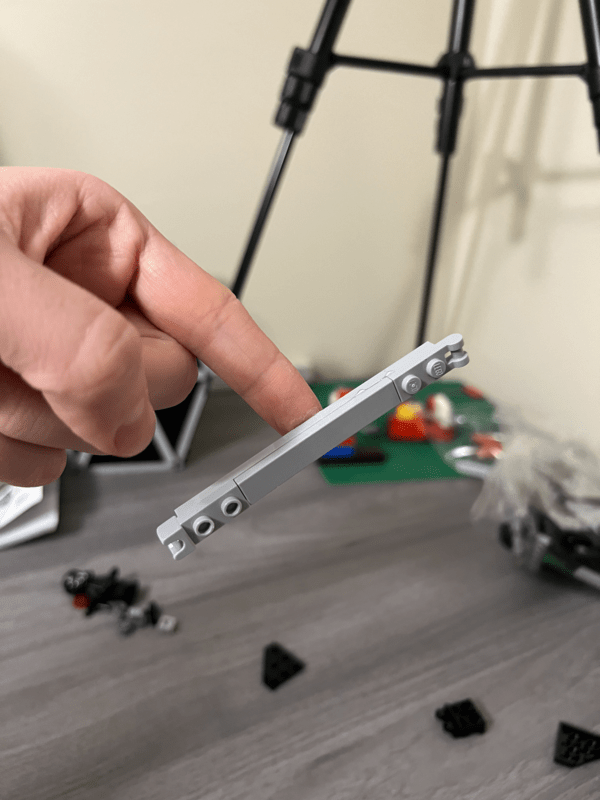
Superglue Showdown: The Smash Test
Here comes the fun part!
I bought three Lego Tie Fighters to smash test them four times. I built one set with no glue, smashed it, and rebuilt it using Le Glue. I then built the two other TIE Fighters with Loctite and Gorilla Glue. I dropped each set on tile floor to see how well the superglue held up.
The results are clear as can be. Gorilla glue was the strongest, Loctite was the second strongest, Le Glue was the weakest superglue, and the set with no superglue was the weakest.
Let’s look at the aftermath of dropping each Lego TIE Fighter.
No Glue (Control Test)
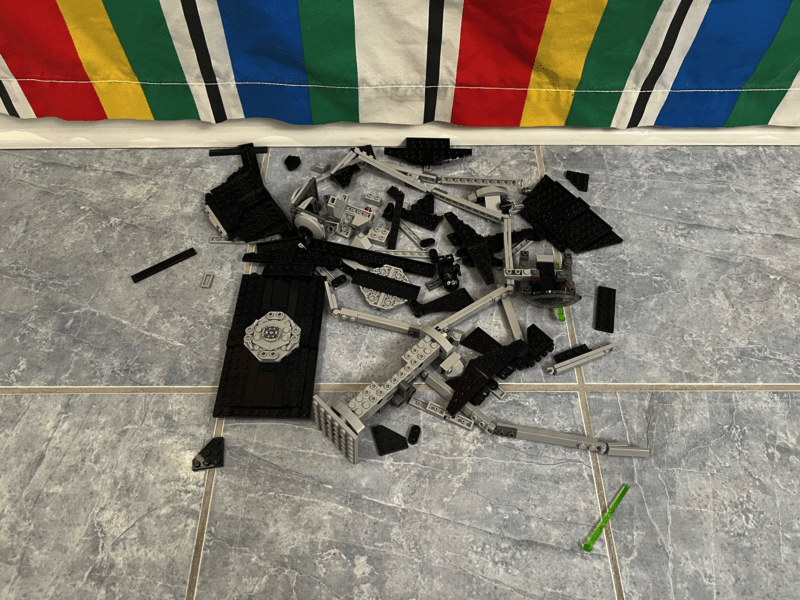
The TIE Fighter with no superglue shattered like glass. There were pieces everywhere, with minimal chunks of bricks that stayed together.
Loctite

Loctite held together more than the control test and Le Glue, but not as much as Gorilla Glue. I feel it’s enough strength to keep your Lego Sets together while on display.
Le Glue
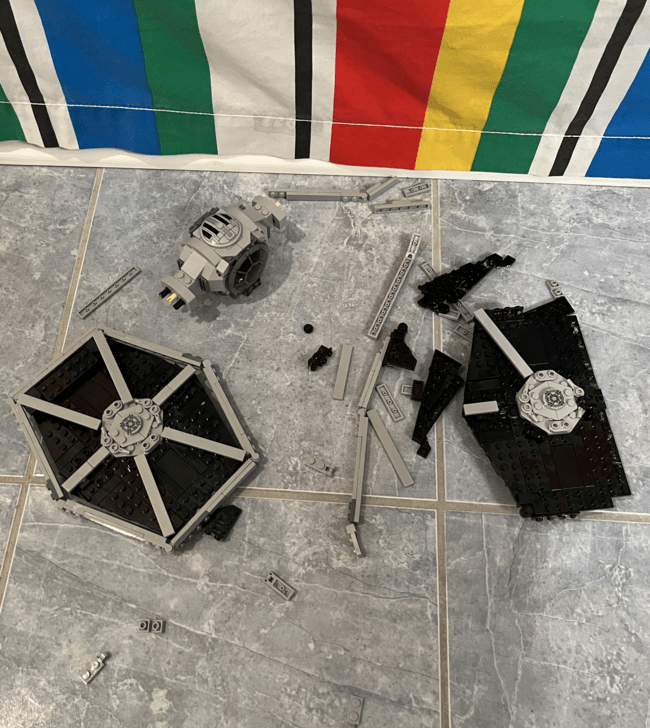
Le Glue held together pretty well in the crash test. The bricks aren’t as secured as the other two glues, whereas I can pull it apart fairly easily. It wasn’t as strong as Loctite and Gorilla Glue, but the fact that it washes away with warm water makes this a viable glue.
Gorilla Glue
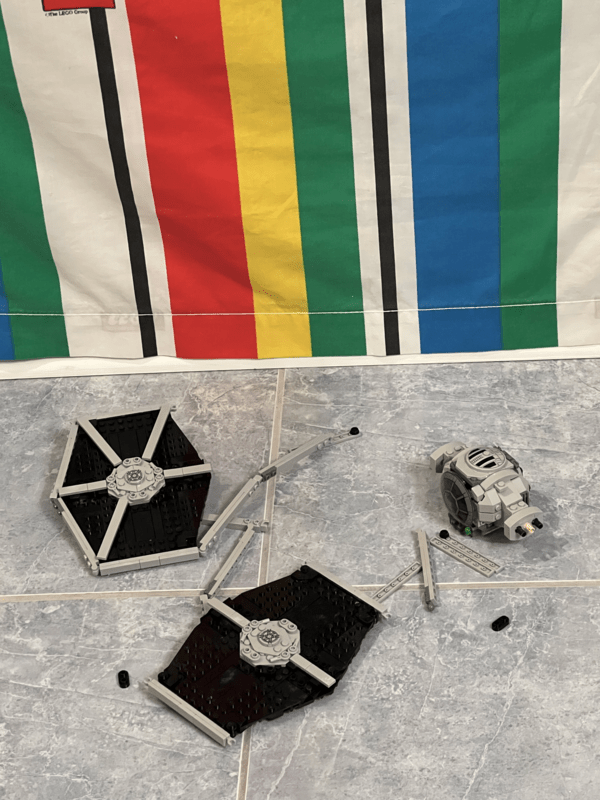
Gorilla Glue was a clear winner in strength. It hardly broke apart when dropped. The wings separated from the cockpit because I didn’t glue these parts together. Believe me when I say that this TIE Fighter feels like a solid brick.
Is it worth Super Glueing your Lego Sets?
I do not think it’s worth superglueing your Lego Sets. I know it’s counterintuitive for me to say that, and spend all this money on Legos and superglue for this article. The issue is that superglued sets are hard to modify, take longer to build, and lose their resale value.
I find the cons outweigh the pros, but it all comes down to what you want to do with your Lego creation. If you’re building a huge city diorama or Star Wars battle scene, it would make sense to superglue your Legos. Let’s go through a few of the arguments why someone may or may not superglue their Legos.
Superglued sets are more durable and better for display.
Let’s get the obvious out of the way first. If you superglue each brick in your your Lego sets, you won’t have to worry as much about them breaking if they fall over. From my crash testing, they don’t exactly stay in one piece, even when super glued. They’re much more durable than a non-superglued set. When I crash tested a non-superglued Tie Fighter, it shattered like glass.
It takes 67.67% more time to build Lego Sets with superglue.
It took 39 minutes and 38 seconds to build the Lego set without any glue. It took nearly two hours to build it with super glue. At 432 pieces, this means I was building 10.8 pieces a minute without superglue, and 3.6 pieces a minute with superglue. That means building with super glue is 66.67% slower than building without it.
With this information, you can figure out whether or not it’s worth superglueing your Lego sets. I’d consider myself an average Lego builder, so just assume you’ll build at the same pace I do. If you were to build the Lego Death Star (75159), which has 4016 pieces, it would take 371 minutes or 6 hours and 11 minutes. That’s assuming you don’t take any breaks.
If you were to use super glue, expect this afternoon project to take a LOT longer. At 3.6 pieces a minute with 4016 pieces total, this build will take 1116 minutes or 18 hours and 36 minutes.
Just divide the total number of pieces by 10.8, or 3.6 if you’re building with super glue. That’ll give you an idea of how many minutes you’ll spend building. Nobody tells you this when giving you recommendations for super glue, and I found it the building process to be painfully slow.
Superglued sets are much harder to resell.
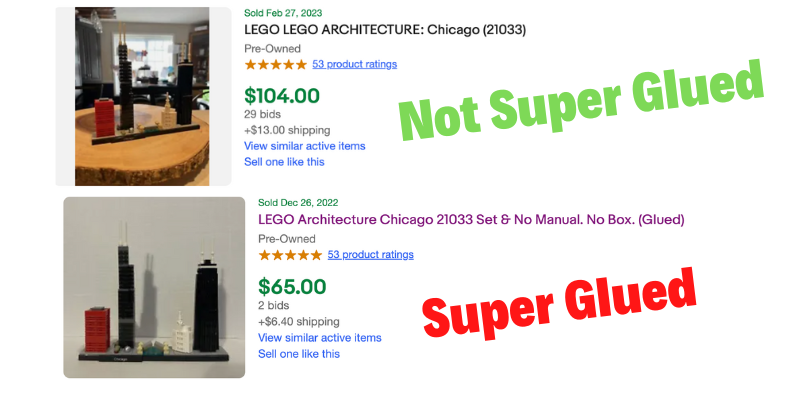
Lego Sets that are superglued are no longer valuable to collectors. They lose their ability to be modified, broken down, and put back in their box. If you take a look on eBay, it’s difficult to find a Lego Set that doesn’t lose their value after being superglued. I struggled to find many listings of superglued sets at all.
If you want to superglue your sets, and keep their resale value, I’d use Le Glue. I still believe Loctite to be a better building experience and a stronger hold, but Le Glue washes away with warm water.

